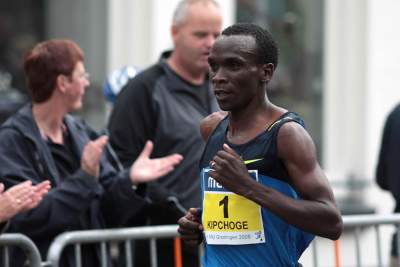Pheidippides, in all his glory, real or mythical, inspired a competitive sport that everyone knows of today. The marathon was created in 1896 for the purpose of becoming the first Olympic event.
The marathon has recently taken an exciting turn. Eliud Kipchoge broke the mythical 2-hour Marathon mark with his 1:59:40 run and Brigid Kosgei won the Chicago Marathon by breaking the women’s world record, but this is not where the excitement stalls. It is a story of awe and wonder with themes of hope and war and of course, a run that covers a distance longer than that from Manama to Doha (hypothetically speaking) or Seoul to Pyongyang!

Eliude Kipchoge
“Eliud Kipchoge.jpg” by The Wolf (User: The Wolf) is licenced under Creative Commons Attribution 2.0.
In the earliest accounts of this story, Pheidippides, the legendary courier, ran approximately 240 kilometres, on the orders of the Athenian military to ask the Spartans for help in defeating the Persians in, what came to be known as the Battle of Marathon.
Pheidippides was not an ordinary infantry soldier who was taken out of the battle and instead forced to run a distance of those proportions to ask the Spartans for help. He was a ‘day runner’ or ‘courier’, a hemerodrome in Ancient Greek. Day runners were specifically employed by the Athenian military to run long distances and deliver messages of this sort. Their training regime was as gruelling as that of any professional athlete, and they trained specifically for situations like this. Well, maybe not for 240 kilometres straight! How did 480 kilometres of running inspire a sporting event that only lasts for 42.195 kilometres?
As the legend goes, not only did he run 240 kilometres from Marathon to Sparta, but upon his arrival, the Spartans notified him that they could not possibly come to the aid of the Greeks on such short notice. Pheidippides, the legend that he was, departed for Athens on his return journey, running another 240 kilometres to pass on this information to his countrymen.
How did 480 kilometres of running inspire a sporting event that only lasts for 42.195 kilometres? Well, unfortunately for Pheidippides, his running that week did not end after he arrived in Marathon.
Upon his arrival, Pheidippides was once again asked to run, much like Forrest [Gump], to Athens. This time, it was because the Greeks had won the battle of Marathon, proving too strategically and tactically sound for the much larger Persian army. They wanted to let the Athenians know that victory was theirs.
The distance from Marathon to Athens was a mere 40 kilometres, relative to the journey Pheidippides had only just completed! And they asked him to deliver the words ‘we win!’. So, off he went, running to deliver this message, after all, the Greeks had won the battle, but as he arrived and announced the words, poor old Pheidippides collapsed, and lived no more.
There were several poems and stories written about this legend. The most popular being Pheidippides by Robert Browning, in 1879 [Excerpt]:
‘Run, Pheidippides, one race more! the meed is thy due!
‘Athens is saved, thank Pan,’ go shout!” He flung down his shield,
Ran like fire once more: and the space ‘twixt the Fennel-field
And Athens was stubble again, a field which a fire runs through,
Till in he broke: “Rejoice, we conquer!” Like wine thro’ clay,
Joy in his blood bursting his heart, he died, the bliss!’
As you may have gathered, this story was not completely true. Some have argued that Pheidippides did exist, running that 40 kilometre stretch from Marathon to Athens, while others have dismissed it as a legend. Others also stated that it may have been true, but the story was merged with that of the Athenian forces marching from Marathon to Athens to defeat the Persian ships!
Pheidippides takes his last breath as he hands over the letter to the Athenians
Whatever it may be, Pheidippides, in all his glory, real or mythical, inspired a competitive sport that everyone knows of today. The marathon was created in 1896 for the purpose of becoming the first Olympic Marathon. According to Hugh Jones, ‘two runners departed from Athens and completed the distance but one of them, foreshadowing many similar instances, took a ride for part of the way’.
This eventually resulted in the first-ever marathon race and set in motion the events which we have been celebrating recently – the breaking of world records in both men’s and women’s categories of the Marathon.
Today, if you make your way along Marathon Road in Rafina, Greece, you will see the modern Bronze statue of Pheidippides as he hands over those words, that etched him into history.
And following on from this legacy, Eliud Kipchoge, set out to break a record, with the support of several staff members, and he was able to achieve what was once thought to be unthinkable - the 2-hour Marathon mark. In turn, taking a legend and breaking a myth, Eliud Kipchoge will also forever be etched into the history of the Marathon.

